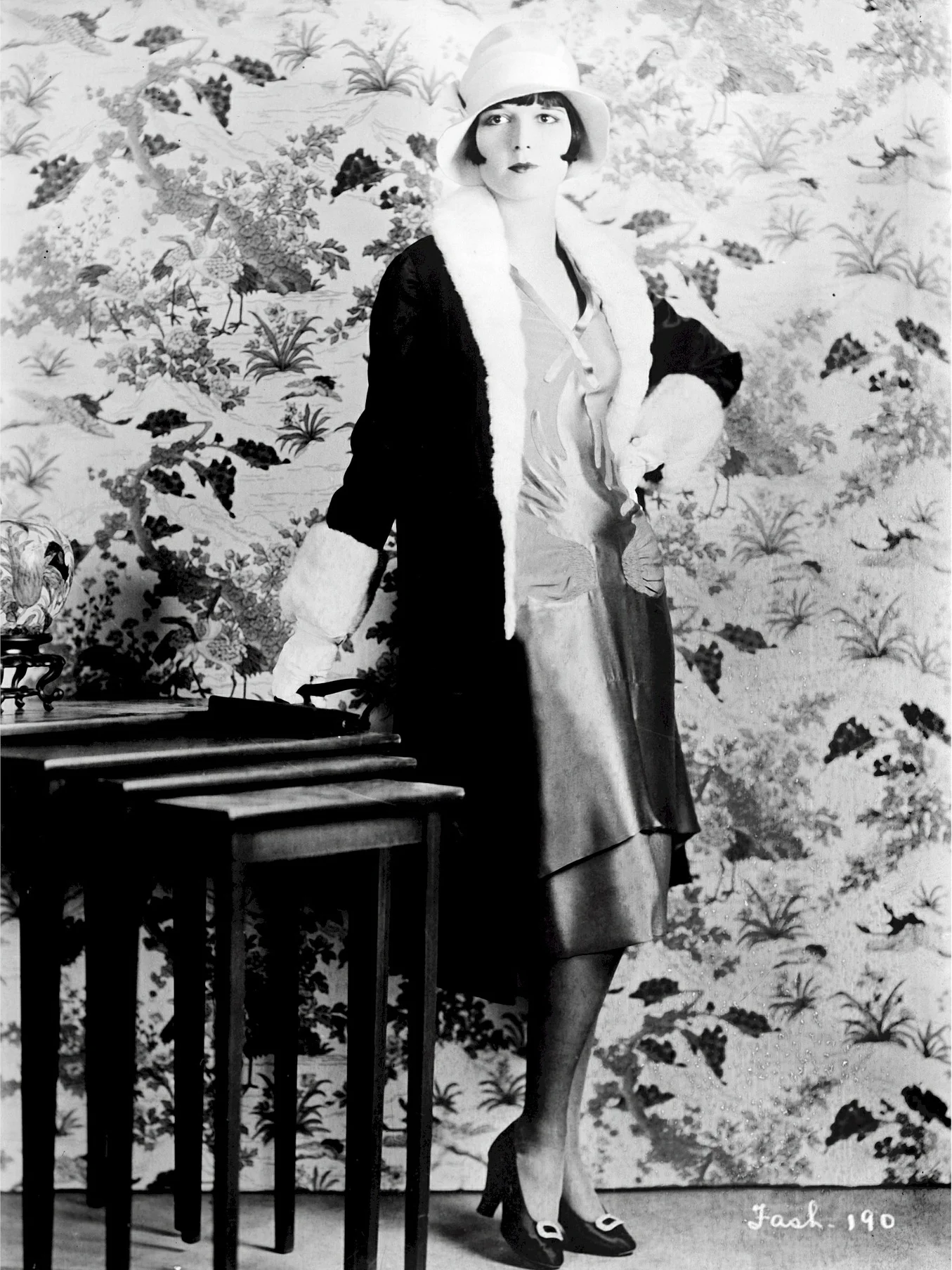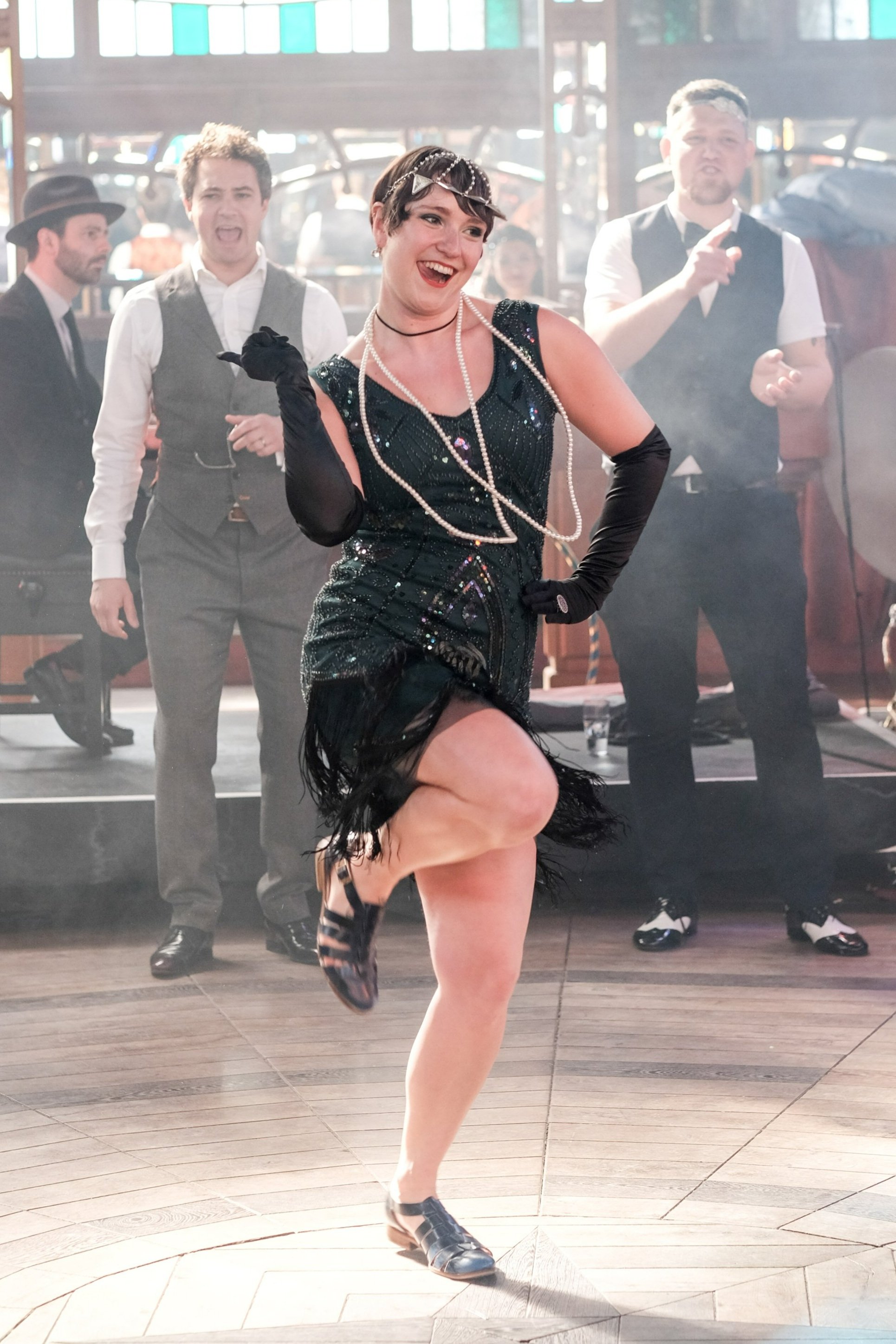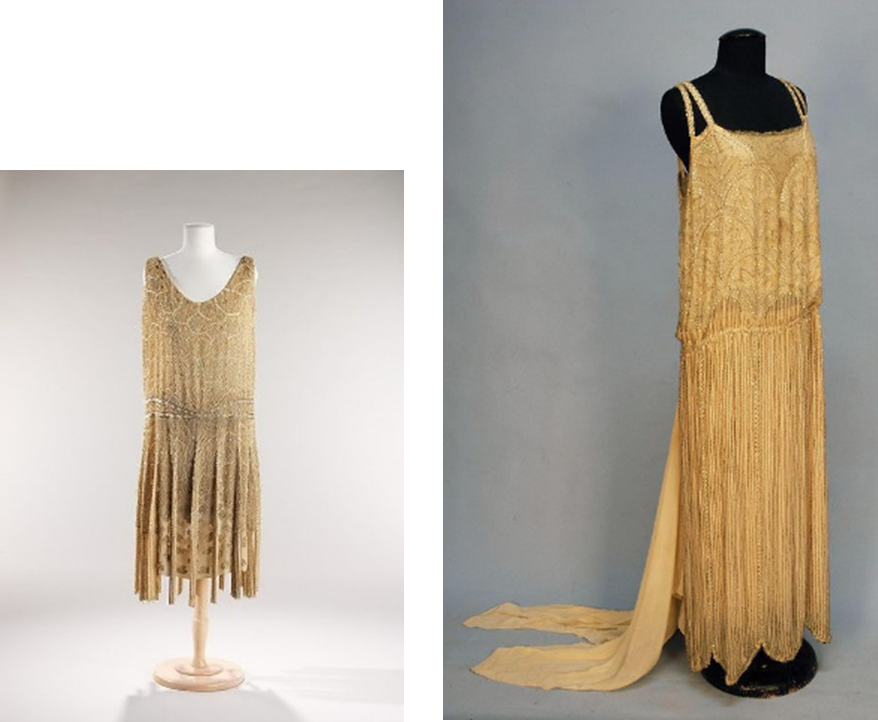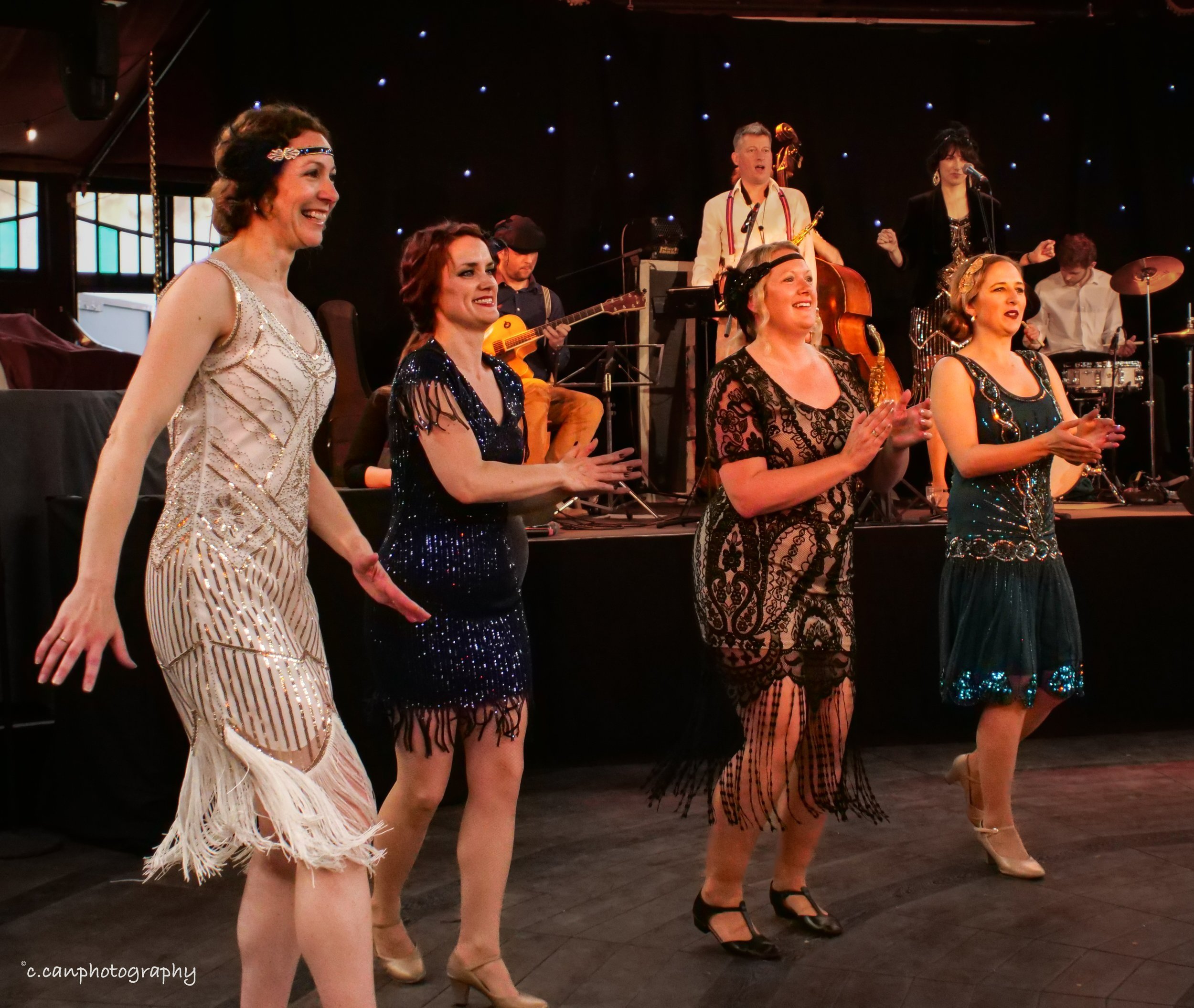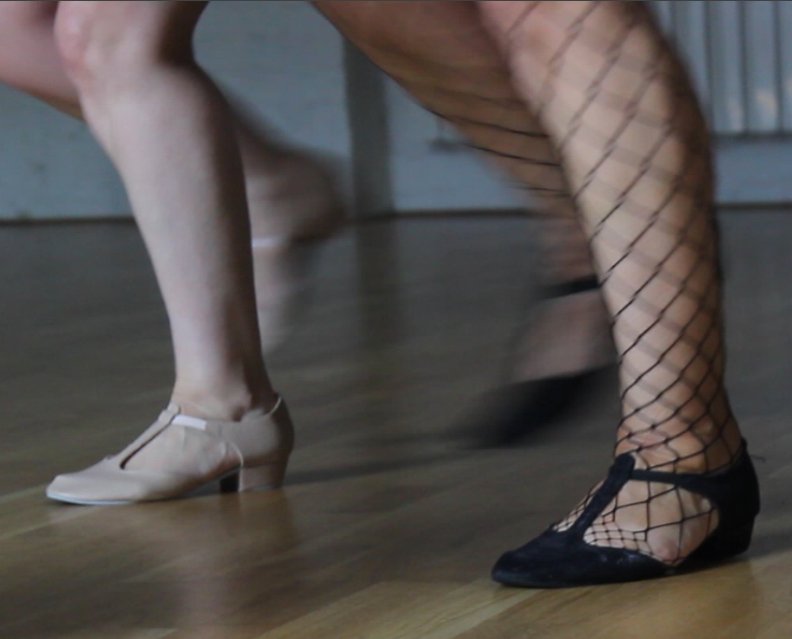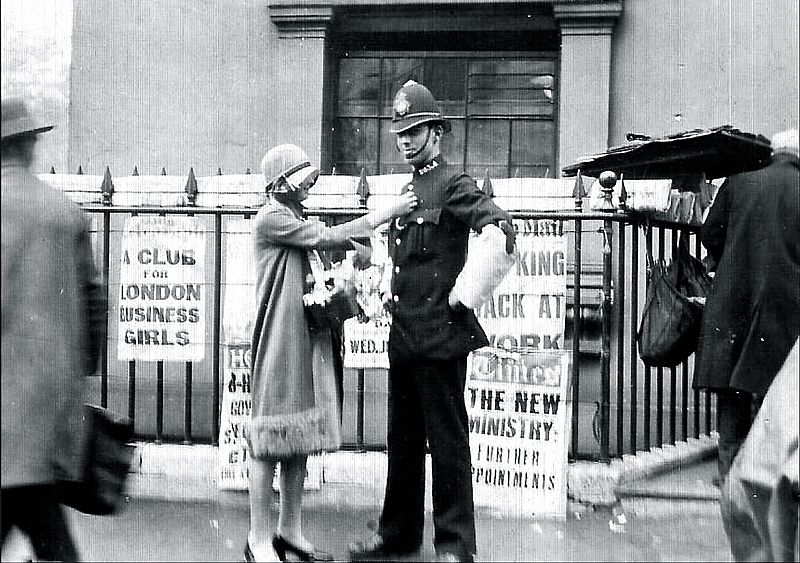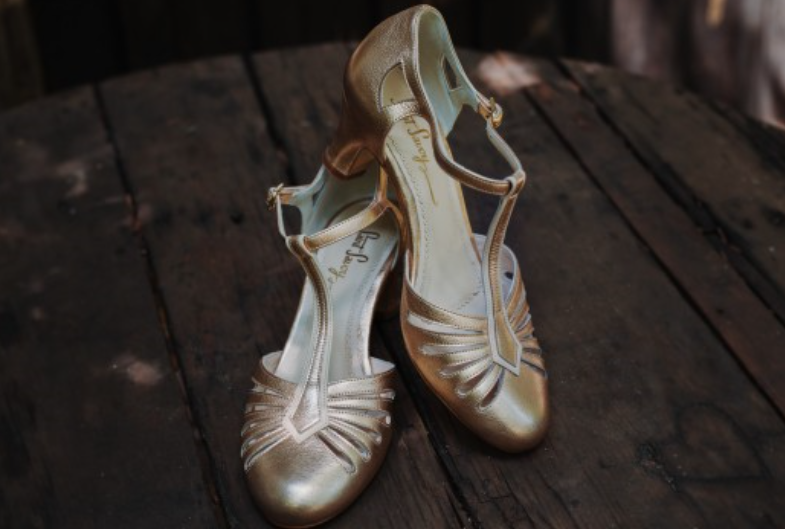
BLOG
Read about all things Charleston
3 flapper girls you must know
In the 1920s flappers girls broke the image of what a traditional woman should be. They cut their hair short, wore make-up and are what many considered the "modern" woman, breaking away from victorian womanhood. Flapper girls Josephine Baker, Clara Bow and Louise Brooks are maybe the most most famous three from the era but what made them stood out and stand the test of time?
In the 1920s flappers girls broke the image of what a traditional woman should be. They cut their hair short, wore make-up and are what many considered the "modern" woman, breaking away from victorian womanhood. Flappers Josephine Baker, Clara Bow and Louise Brooks are maybe the most famous three from the era but what made them stood out and stand the test of time?
Josephine Baker
JOSEPHINE BAKER
Josephine Baker was born in Missouri in 1906. Originally she was named Freda Josephine McDonald, but after immigrating to France she was known as Josephine Baker.
She is one of the most famous Charleston dancers of the era and her career began as a street dancer, which attracted attention and helped her being recruited as a dancer for the St. Louis Chorus Vaudeville show at the age of 15. Not long after this, she moved to New York City where she performed at the Plantation Club and in the Broadway chorus line of Shuffle Along and The Chocolate Dandies.
After New York, she moved to Paris in France where she stayed until she died. Her Danse Sauvage brought her success overnight, because her skirt was consisting only of a griddle of artificial bananas. It’s one of her most famous pictures and a symbol of the Jazz of the 1920s, and it also gave birth to the term “Art Deco”.
Baker was not only an entertainer but also an activist. During World War Ⅱ, she aided the Red Cross, the French Forces and the French Resistance. And in the United States she refused to perform for segregated audiences and is noted for her involvement in the Civil Rights Movement. In 1975 Josephine Baker died in France.
Louise Brooks
LOUISE BROOKS
Louise Brooks, who was born in 1906, has one of the most iconic flapper looks: Her bobbed hair, The American was a famous dancer, an actress and later in her life an author. She came into the spotlight as Lulu in the film Pandora’s Box.
Her career began at the age of 15, when Brooks dropped out of school to move to New York City to join the Denishawn dance troupe. She performed two seasons with Denishawn, but was dismissed at the end of her second season, because St. Denis, one of the most renowned artists of that time, thought that Brooks was possessed by a superior attitude.
After this, she found work as a Broadway chorus girl and became a Zeigfeld showgirl.
Brooks travelled to England, where she found work at the city’s famed Café de Paris and became the first person to dance the Charleston in London. This helped her get noticed by film star Charlie Chaplin, with whom she had an affair that lasted one summer.
When Brooks was 18 years old, she signed a five-year contract with Paramount, which is still a leading film studio, but in her days, she was never really considered a major star in the film industry. In 1985 Louise Brooks died of a heart attack.
Clara Bow
CLARA BOW
Clara Bow, born Clara Gordon Bow in 1905 was an American actress which became famous through silent films during the 1920s.
At the age of the 16 she participated at the nationwide acting contest, because previous winners got film roles, and Bow wanted to be an actress. She won an evening gown and a silver trophy, but the breakthrough never came after the competition.
In 1921 Bow was introduced to the director Christy Cabanne, who cast her in Beyond the Rainbow and was really impressed by her, but she was cut out in the final print. Bow dropped out of school after this incident and worked a normal job.
But her father encouraged her to keep looking for a film role because it was a huge dream of her. In 1923 she was featured in the silent film Down to the Sea by Elmer Clifton, which helped her getting known as an actress.
One year later Bow got her first lead role in the film Poisoned Paradise.
The appearance in the film It brought her global fame and the name “The It Girl”. Now she is still the personify to the Roaring Twenties and is often described as its leading sex symbol.
In 1965 she died of a heart attack.
The 20s Flapper Dress - The scandalous dress that empowered women
In the 1920s the flapper dress was a staple piece of clothing in every woman’s wardrobe. It enhanced their figures, allowing them to move freely to dance but those who wore it was also viewed as reckless partygoers…
There have been many iconic styles of fashion throughout the decades in history. We have all heard of Dame Barbara ‘Mary Quant’ and her 1966 creation of the mini skirt and Regency Ballgowns from Jane Austen’s novels. However, there is one piece of clothing that often gets forgotten about amidst the millions of other styles. An outfit so revolutionary it went down in history and became a staple piece in every woman’s wardrobe for over 10 years.
Yes, you guessed it! We can be talking about none other than the 1920s Flapper Dress…
As we are returning once again to the ‘20s, fashion from the decade has made quite the come back with more and more people falling in love with the whole style and vibe. So, let’s find out why this dress is so iconic…
What is a Flapper Dress and why is it widely recognised?
During the turn of the century, fashion was changing as women were gradually moving away from the suffocating corsets and stiff, long skirting in favour of a style which enhanced their figures as opposed to restricting them. The Flapper Dress ignited this change as it is relatively simple in terms of style and came to just below the knee in length (scandalously short for the time).
The silhouette in the 1920s was known as, ‘la garçonne’ which illustrated the youthful figure which was desired by many women throughout the ‘20s. Suddenly, women’s fashion was not about maintaining high levels of, ‘modesty’ and instead it became about empowering women to take control and physically break free from the societal constraints and pressures to conform to the rules of the ‘traditional woman’ in an attempt to abolish the idea that they should dress for their husbands.
The Development of The Flapper Dress Throughout the Decade:
Dressing up was once a restrictive activity and one that richer women in society were permitted to participate in. This was due to the overly expensive and Avant Garde embellishments that were added to many outfits and accessories. However, the 1920s made the act of dressing up more accessible as the Flapper Dress could easily be made at home, thanks to its simple structure and the eradication of the corset.
During the early years of the 1920s, the concept of the ‘Flapper Dress’ was beginning to form. This led to women being viewed as reckless as they drank, smoked, and danced the decade away. With waistlines dropping below the hip and hemlines slowly creeping up to above the knee, by 1925, the previous Victorian style of dress had been forgotten about and short, simple Flapper Dresses were the new, notable look. However, by the end of the decade, the idea of shorter hemlines crashed, as did Wall Street, and the fashion industry decided to return to the glamorous and curvaceous silhouette in the early 1930s.
What makes a Flapper dress
There are many specific characteristics that define a Flapper Dress and make it so recognisable- even today! They generally hang straight down the body with an uneven split hem, were sleeveless and most importantly were made out of light, loose fabrics. This not only allowed for dances such as The Charleston to be danced with ease, but it also revitalised body confidence in women.
For added pizzazz and glamour, many adorned their dresses with beading or sequins sewn into intricate designs as well as wore accessories such as pearls, feathers, and facemasks.
Famous Flapper Dresses
Like many other vintage eras throughout history, the 1920s was no different when it came to showcasing the iconic fashion that was prevalent during this time. The well-known designer Edward Molyneux was among the many to create a dress so ‘flapper-tastic’ that it went down as one of the most iconic in history. Molyneux was an extremely prestigious fashion designer throughout the decade. He created many elegant evening-wear Flapper Dresses that became a popular choice in elite social circles, even becoming first choice with many actresses and stage performers; including Greta Garbo. His imaginative creations were among the first to incorporate unconventional patterns using crystals or beading as well as experimenting with ostrich feathers and comically shaped buttons. His extravagant designs led him to open multiple fashion houses throughout Paris where he became a style trendsetter.
One of his most famous pieces of work was a 1925 Flapper Dress which perfectly encapsulated what the 1920s was all about. The dress symbolised glamour yet was minimalistic in terms of style. This particular dress became a statement piece and was used to set an example to this new, growing fashion trend.
Flapper Dresses in the Modern Day
The Flapper Dress is a style that is still very much associated with the 1920s, however, that hasn’t stopped it regaining popularity 100 years on. This style of dress has become a common choice for vintage fashion collectors and as a result, these dresses are now considered an ‘investment fashion piece.’
They have also become the fancy-dress must-have when throwing a vintage themed party.
Over the years, MyCharleston have also seen and worn some stunning 1920s outfits at our annual Speakeasy. Ranging from full blown Flapper to Swing Dresses; there really are so many amazing styles that stem from the 1920s.
With all the tassels, sequins, beading and pearls, I think it’s safe to say that the legacy of the Flapper Dress still lives on and will hopefully continue to do so. After all, this historical style of dress is certainly one of a kind…
By Eleanor O'Donnell
Charleston Shoes - What to choose?
From Han Christian Andersen’s Red Shoes to Cinderella’s glass slippers, dance shoes have often been imbued with magical qualities. So how important is it to get the right shoes when dancing the Charleston? Whilst in many dance forms just bare feet is fine, The Charleston really does require the right footwear.
From Han Christian Andersen’s Red Shoes to Cinderella’s glass slippers, dance shoes have often been imbued with magical qualities. So how important is it to get the right shoes when dancing the Charleston? Whilst in many dance forms just bare feet is fine, The Charleston really does require the right footwear.
The main reason shoes are so important in Charleston is so you can swivel the feet; the foot swivel is a defining characteristic of the Charleston style so non-grip shoes are a must. Back in the day dance floors were waxed and offered a lot of glide, modern dance floors and studios are smooth but not slippy. The dilemma then is getting shoes which offer some glide but not so much that you end up kissing the floor with your bum. Another thing to consider is how much support the shoes offer the foot, if you have weak ankles or collapsed foot arches you will need more supportive shoes.
So here is the low down on shoes we know and love and the pros and cons of each …
Greek Sandals – Cheap, light, strike a good balance between grip and slide. The down side is they don’t offer much support and they definitely aren’t outdoor shoes, so save them for the dance studio and you’ll perfect your swivel in no time.
Jazz Trainers – More on the grippy side but offer good support to the foot, super comfy and hardwearing.
Jazz Shoes – Light and good for swivel, again they offer limited support but one up on Greek sandals.
Toms – These fashion shoes are very popular in the Lindy Hop scene. They are a solid pair of shoes, good on swivel but the soles don’t offer great flexibility.
Character Shoes – A lot of dancer find a bit of heel is actually quite helpful. I’m a big fan of character shoes but would advise going to a dance shop and getting ones which are a really good fit, if the feet are in any way sliding within the shoes you will feel unstable.
Fashion Shoes – Well its luck of the draw but some of the best shoes people have showed up to class in have been bought in Charity Shops – Win! Often in the style of pumps or brogues the best ones tend to be made of softish leather and with leather soles which offer glide.
For a list of recommended shoes, take a look at our shopping list here: https://mycharlestondance.com/shoes
Happy Shoe Shopping!
Fiona
3 flapper girls you must know
In the 1920s flappers girls broke the image of what a traditional woman should be. They cut their hair short, wore make-up and are what many considered the "modern" woman, breaking away from victorian womanhood. Flapper girls Josephine Baker, Clara Bow and Louise Brooks are maybe the most most famous three from the era but what made them stood out and stand the test of time?
In the 1920s flappers girls broke the image of what a traditional woman should be. They cut their hair short, wore make-up and are what many considered the "modern" woman, breaking away from victorian womanhood. Flappers Josephine Baker, Clara Bow and Louise Brooks are maybe the most famous three from the era but what made them stood out and stand the test of time?
Josephine Baker
JOSEPHINE BAKER
Josephine Baker was born in Missouri in 1906. Originally she was named Freda Josephine McDonald, but after immigrating to France she was known as Josephine Baker.
She is one of the most famous Charleston dancers of the era and her career began as a street dancer, which attracted attention and helped her being recruited as a dancer for the St. Louis Chorus Vaudeville show at the age of 15. Not long after this, she moved to New York City where she performed at the Plantation Club and in the Broadway chorus line of Shuffle Along and The Chocolate Dandies.
After New York, she moved to Paris in France where she stayed until she died. Her Danse Sauvage brought her success overnight, because her skirt was consisting only of a griddle of artificial bananas. It’s one of her most famous pictures and a symbol of the Jazz of the 1920s, and it also gave birth to the term “Art Deco”.
Baker was not only an entertainer but also an activist. During World War Ⅱ, she aided the Red Cross, the French Forces and the French Resistance. And in the United States she refused to perform for segregated audiences and is noted for her involvement in the Civil Rights Movement. In 1975 Josephine Baker died in France.
Louise Brooks
LOUISE BROOKS
Louise Brooks, who was born in 1906, has one of the most iconic flapper looks: Her bobbed hair, The American was a famous dancer, an actress and later in her life an author. She came into the spotlight as Lulu in the film Pandora’s Box.
Her career began at the age of 15, when Brooks dropped out of school to move to New York City to join the Denishawn dance troupe. She performed two seasons with Denishawn, but was dismissed at the end of her second season, because St. Denis, one of the most renowned artists of that time, thought that Brooks was possessed by a superior attitude.
After this, she found work as a Broadway chorus girl and became a Zeigfeld showgirl.
Brooks travelled to England, where she found work at the city’s famed Café de Paris and became the first person to dance the Charleston in London. This helped her get noticed by film star Charlie Chaplin, with whom she had an affair that lasted one summer.
When Brooks was 18 years old, she signed a five-year contract with Paramount, which is still a leading film studio, but in her days, she was never really considered a major star in the film industry. In 1985 Louise Brooks died of a heart attack.
Clara Bow
CLARA BOW
Clara Bow, born Clara Gordon Bow in 1905 was an American actress which became famous through silent films during the 1920s.
At the age of the 16 she participated at the nationwide acting contest, because previous winners got film roles, and Bow wanted to be an actress. She won an evening gown and a silver trophy, but the breakthrough never came after the competition.
In 1921 Bow was introduced to the director Christy Cabanne, who cast her in Beyond the Rainbow and was really impressed by her, but she was cut out in the final print. Bow dropped out of school after this incident and worked a normal job.
But her father encouraged her to keep looking for a film role because it was a huge dream of her. In 1923 she was featured in the silent film Down to the Sea by Elmer Clifton, which helped her getting known as an actress.
One year later Bow got her first lead role in the film Poisoned Paradise.
The appearance in the film It brought her global fame and the name “The It Girl”. Now she is still the personify to the Roaring Twenties and is often described as its leading sex symbol.
In 1965 she died of a heart attack.
Flappers & Feminism
The early decades of the 20th century were a battleground for women, in terms of political and legal reform. But women were also testing out another arena of emancipation: their bodies. As fashions grew simpler and skirts rose higher, reaching knee-length by the late 1920s, women found new physical freedom.
Read extracts from Judith Mackrell’s article on our blog. Original article can be found here
The early decades of the 20th century were a battleground for women, in terms of political and legal reform. But women were also testing out another arena of emancipation: their bodies. As fashions grew simpler and skirts rose higher, reaching knee-length by the late 1920s, women found new physical freedom.
Josephine Baker dancing the Charleston at the Folies-Bergère, Paris
On the dancefloor, too, women were displaying an alarming lack of modesty, with the social dances that began spreading through the west just before the first world war. Driven by the rhythms of American ragtime, the Bunny Hug, the Turkey Trot and the Grizzly Bear.
These encouraged dancers to kick up their feet, rock crazily from side to side and lock their swaying pelvises together. To the young these ragtime dances were part of a new "budding freedom", a sign that "Victorianism" had finally lost its grip.
Nightclubs had begun to appear in London in 1912, these dark and crowded basements promised a cocktail of illicit thrills: smoking cigarettes, wearing lipstick, drinking Pink Ladies – and dancing.
In the 1920s, ragtime was superseded by the wayward jangle and bounce of the Charleston and by the pert, buttock-flourishing naughtiness of the Black Bottom. Zelda Fitzgerald, famously the inspiration for her husband F Scott's fictional flapper heroines, was also a wicked exponent of the decade's jazz dances.
If dances were getting wilder, so too were morals. Between 1914 and 1929, the divorce rate doubled in the US and surveys reported that premarital sex was rising even faster. The promiscuity of young women caused alarm, particularly in Britain. The Daily Mail warned that the number of "superfluous" females could be a "disaster to the human race" (clearly the Daily Mail’s attitudes haven’t advanced much, as they are still spouting the same sexist bullsh*t today!)
Young flappers may have thrown off the tyranny of the corset, but they discovered the new tyranny of dieting! Which still lives on today!
The flapper represented a new spirit of emancipation. If women were to follow their "inner compulsion to be individuals", they had to throw off their shackling inheritance of obedience, whether to the puritanical tenets of old-school feminism or to the sentimentalised duties of marriage and motherhood. It wasn't hardcore politics but, on the dancefloor at least, these women of the 1920s embodied Bromley's views. As they shimmied their shoulders and swivelled their hips, they were released into a brief but deeply subversive world – a world of freedom.
This blog was put together from extracts of Judith Mackrell’s article on the Guardian. Read Full article here
MOVE IT 2019
MOVE IT is the world’s biggest dance event, celebrating all forms of dance and the performing arts across three amazing days. Big names in the dance world grace the stage every year and 2019 was no exception with performances from Strictly Come Dancing power couple Neil and Katya Jones, JLS frontman Aston Merrygold and Greatest Dancer winner Ellie Ferguson. Needless to say that once we had been accepted to perform on the Main Stage and teach at this years show I felt excited, nervous, honoured and a bit sick…
MOVE IT is the world’s biggest dance event, celebrating all forms of dance and the performing arts across three amazing days. Big names in the dance world grace the stage at the Excel London every year and 2019 was no exception. This years headliners included Strictly Come Dancing power couple Neil and Katya Jones, JLS frontman Aston Merrygold and Greatest Dancer winner Ellie Ferguson. Needless to say that once we had been accepted to perform on the Main Stage and teach at this years show I felt excited, nervous, honoured and a bit sick…
Move it 2019 - Main Stage
When you are dancing and sharing a stage alongside the hottest artists and talent in the UK we had to pull out all the stops. Planning started back in December with Fiona and our dance captain Rachel on what our show stopping performance was going to be. After hours of brain storming we chose the song ‘Hold that Tiger’ by the California Feetwarmers and put together a circus themed routine: The Ringmaster and her Tigers.
Over the next 9 weeks the team worked endlessly on every little detail on the performance. Rachel put together a fantastic routine and our 12 piece troupe worked extra hours in bringing it together. Alongside of this everyone chipped in on the finer details. One afternoon Elena and dance troupe member Mila spent 6 hours preparing the dresses and making 22 tiger ears! Another dancer, Serafine, was awake until 1.30am the night before sewing the ringmasters costume whilst Rachel spent the day painting a barrel to turn into a podium. These may seem like small things to worry about but all the small details bring the performance together. Alongside of music, there is also the logistics, the extra studio bookings, the music that needs cutting, the transport to get there and the hair and make-up which needs to uniformed.
Fiona Ring and Elena Collins at MOVE IT 2019
The energy on the day was electric however the team were controlled, prepared and pulled out what we consider one of our best performances to date. Our number was between the Greatest Dancer finalists and we delighted by the crowds energy and enthusiasm for us on stage. We were the only Charleston act there, nearly everything else was contemporary or street so we felt we brought something totally different to the stage. We were properly also the oldest dancers there, most performers where bendy 16 year olds auditioning for stage school but we felt proud to show that dance is for everyone regardless of age… and how unbendy you are!
After the performance I felt quite emotional. I am so proud of our dancers and of how far our team have come together. Fiona, Rachel and I started working together 5 years ago and I never dreamed that MyCharleston would be on the Main Stage of MOVE IT. It really was a dream come true… and to top it off we even got a snap with Neil and Katya from Strictly!
Rachel teaching at Move it 2019
Rachel and Elena with the Strictly Come Dancing Pros.
After the performance we taught a sold out workshop which was a master class in Charleston where Portsmouth and Ryde teacher Mel joined us. It was great fun and a privilege to be the only people teaching Charleston over the whole weekend.
Our video from the performance will be released soon so keep an eye our for the final video!
Elena
The Ring Master and her Tigers. MyCharleston dance troupe at Move It 2019.
How dance helped women’s liberation
The early decades of the 20th century were a battleground for women, in terms of political and legal reform. But women were also testing out another arena of emancipation: their bodies. As fashions grew simpler and skirts rose higher, reaching knee-length by the late 1920s, women found new physical freedom.
Read extracts from Judith Mackrell’s article on our blog. Original article can be found here
The early decades of the 20th century were a battleground for women, in terms of political and legal reform. But women were also testing out another arena of emancipation: their bodies. As fashions grew simpler and skirts rose higher, reaching knee-length by the late 1920s, women found new physical freedom.
Josephine Baker dancing the Charleston at the Folies-Bergère, Paris
On the dancefloor, too, women were displaying an alarming lack of modesty, with the social dances that began spreading through the west just before the first world war. Driven by the rhythms of American ragtime, the Bunny Hug, the Turkey Trot and the Grizzly Bear.
These encouraged dancers to kick up their feet, rock crazily from side to side and lock their swaying pelvises together. To the young these ragtime dances were part of a new "budding freedom", a sign that "Victorianism" had finally lost its grip.
Nightclubs had begun to appear in London in 1912, these dark and crowded basements promised a cocktail of illicit thrills: smoking cigarettes, wearing lipstick, drinking Pink Ladies – and dancing.
In the 1920s, ragtime was superseded by the wayward jangle and bounce of the Charleston and by the pert, buttock-flourishing naughtiness of the Black Bottom. Zelda Fitzgerald, famously the inspiration for her husband F Scott's fictional flapper heroines, was also a wicked exponent of the decade's jazz dances.
If dances were getting wilder, so too were morals. Between 1914 and 1929, the divorce rate doubled in the US and surveys reported that premarital sex was rising even faster. The promiscuity of young women caused alarm, particularly in Britain. The Daily Mail warned that the number of "superfluous" females could be a "disaster to the human race" (clearly the Daily Mail’s attitudes haven’t advanced much, as they are still spouting the same sexist bullsh*t in 2019!)
Young flappers may have thrown off the tyranny of the corset, but they discovered the new tyranny of dieting! Which still lives on in the year 2019!
The flapper represented a new spirit of emancipation. If women were to follow their "inner compulsion to be individuals", they had to throw off their shackling inheritance of obedience, whether to the puritanical tenets of old-school feminism or to the sentimentalised duties of marriage and motherhood. It wasn't hardcore politics but, on the dancefloor at least, these women of the 1920s embodied Bromley's views. As they shimmied their shoulders and swivelled their hips, they were released into a brief but deeply subversive world – a world of freedom.
This blog was put together from extracts of Judith Mackrell’s article on the Guardian. Read Full article here
Our new merchandise
We are currently offering new merchandising which you can pre-order until the 24th January and it will be delivered to our classes for collection from 4th February.
We are currently offering new merchandising which you can pre-order until the 24th January and it will be delivered to our classes for collection from 4th February.
We are offering T-Shirts, Vest Tops, Tote & Shoe bags and even Hoodies.
The Tote Bags is 42 x 38cm with cotton handles and for the Shoe Bags, you could order a small on which is 25 x 30cm big or a medium on which is 20 x 45cm with a drawstring. In the small shoe bag fits one pair of shoes and the Tote and medium bags can hold two pairs of shoes or shoes with a dance kit and a bottle of water.
All bags cost £10.
Bags
T-Shirts
We are offering our T-Shirts for men and women, but our Vest Tops are currently only available for women. Both, the T-Shirts and the Vest Tops, cost £15.
Hoodies
we are now offering Hoodies, which cost £35.
For more information about the sizes and if you want to pre-order a product click on the link below.
Charleston Shoes - Where to look?
The most important thing for a dancer is the shoe. For us Charleston dancers it is important to find a shoe, which we are stable in and which has a smooth sole, so that we can swivel over the dance floor. In this blog we would like to introduce you to some shops, which could be interesting in the search for your perfect dance shoe.
The most important thing for a dancer is the shoe. For us Charleston dancers it is important to find a footwear, which we are stable in and which has a smooth sole, so that we can swivel over the dance floor. In this blog we would like to introduce you to some shops, which are worth checking out in the search for your perfect dance shoe.
Aris Allen
Aris Allen is a shoe brand which offers dance shoes with a suede sole for women and men. The shoes are designed by swing dancers for other swing dancers.
Price range: £39 - £62
https://arisallen.com/
Charlie Stone
This brand offers Greek Sandals with a unique design with hidden elevation for better arch, ankle and knee support. All shoes have leather upper and lining and a smooth sole, so that you can swivel perfectly over the dance floor
Price range: £82 – £93
https://www.charliestoneshoes.com/collections/all
Bleyer Shoes
Bleyer Shoes offers many different styles of dance shoes for both, men and women. The brand is run by a UK based company called The Swing Dance Company Limited.
Price range: £40 - £115
http://bleyershoes.com/
Slide&Swing
Slide&Swing is a really new brand, which established in Spain in 2013. You can get dance shoes for both men and women there, and they are all handmade with an upper, lining and sole all in leather, so the shoe is very light and smooth.
Price range: £111 - £155
https://www.slideandswing.es/shop/
Saint Savoy
These dance shoes for men and women are a bit more pricey, but you get really beautiful classic dance shoes with leather soles or synthetic soles. All shoes are tested by professional dancers to see if the shoe really makes a good dance shoe considering the comfort of your feet while dancing.
Price range: £165 - £196
https://www.saintsavoy.com/
If you don’t want to buy dance shoes, because you already have shoes which fit your feet perfectly and you know you could dance in them all night long, but the sole is not smooth enough, you could resole your shoes with a leather sole.
We already wrote a blog about the different types of shoes there are. If you want to know which shoe could be fitting for you and the pros and cons of each type of shoe, you should have a look at Fiona’s blog too!
3 flapper girls you must know
In the 1920s flappers girls broke the image of what a traditional woman should be. They cut their hair short, wore make-up and are what many considered the "modern" woman, breaking away from victorian womanhood. Flapper girls Josephine Baker, Clara Bow and Louise Brooks are maybe the most most famous three from the era but what made them stood out and stand the test of time?
In the 1920s flappers girls broke the image of what a traditional woman should be. They cut their hair short, wore make-up and are what many considered the "modern" woman, breaking away from victorian womanhood. Flappers Josephine Baker, Clara Bow and Louise Brooks are maybe the most famous three from the era but what made them stood out and stand the test of time?
Josephine Baker
JOSEPHINE BAKER
Josephine Baker was born in Missouri in 1906. Originally she was named Freda Josephine McDonald, but after immigrating to France she was known as Josephine Baker.
She is one of the most famous Charleston dancers of the era and her career began as a street dancer, which attracted attention and helped her being recruited as a dancer for the St. Louis Chorus Vaudeville show at the age of 15. Not long after this, she moved to New York City where she performed at the Plantation Club and in the Broadway chorus line of Shuffle Along and The Chocolate Dandies.
After New York, she moved to Paris in France where she stayed until she died. Her Danse Sauvage brought her success overnight, because her skirt was consisting only of a griddle of artificial bananas. It’s one of her most famous pictures and a symbol of the Jazz of the 1920s, and it also gave birth to the term “Art Deco”.
Baker was not only an entertainer but also an activist. During World War Ⅱ, she aided the Red Cross, the French Forces and the French Resistance. And in the United States she refused to perform for segregated audiences and is noted for her involvement in the Civil Rights Movement. In 1975 Josephine Baker died in France.
Louise Brooks
LOUISE BROOKS
Louise Brooks, who was born in 1906, has one of the most iconic flapper looks: Her bobbed hair, The American was a famous dancer, an actress and later in her life an author. She came into the spotlight as Lulu in the film Pandora’s Box.
Her career began at the age of 15, when Brooks dropped out of school to move to New York City to join the Denishawn dance troupe. She performed two seasons with Denishawn, but was dismissed at the end of her second season, because St. Denis, one of the most renowned artists of that time, thought that Brooks was possessed by a superior attitude.
After this, she found work as a Broadway chorus girl and became a Zeigfeld showgirl.
Brooks travelled to England, where she found work at the city’s famed Café de Paris and became the first person to dance the Charleston in London. This helped her get noticed by film star Charlie Chaplin, with whom she had an affair that lasted one summer.
When Brooks was 18 years old, she signed a five-year contract with Paramount, which is still a leading film studio, but in her days, she was never really considered a major star in the film industry. In 1985 Louise Brooks died of a heart attack.
Clara Bow
CLARA BOW
Clara Bow, born Clara Gordon Bow in 1905 was an American actress which became famous through silent films during the 1920s.
At the age of the 16 she participated at the nationwide acting contest, because previous winners got film roles, and Bow wanted to be an actress. She won an evening gown and a silver trophy, but the breakthrough never came after the competition.
In 1921 Bow was introduced to the director Christy Cabanne, who cast her in Beyond the Rainbow and was really impressed by her, but she was cut out in the final print. Bow dropped out of school after this incident and worked a normal job.
But her father encouraged her to keep looking for a film role because it was a huge dream of her. In 1923 she was featured in the silent film Down to the Sea by Elmer Clifton, which helped her getting known as an actress.
One year later Bow got her first lead role in the film Poisoned Paradise.
The appearance in the film It brought her global fame and the name “The It Girl”. Now she is still the personify to the Roaring Twenties and is often described as its leading sex symbol.
In 1965 she died of a heart attack.
Ever fancied learning the Charleston? Check our our courses in studio and online



